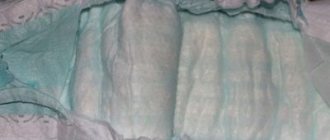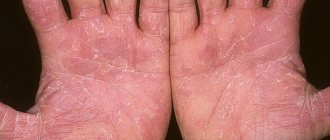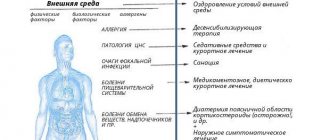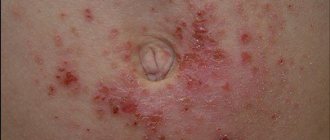Inflammation of the skin in a baby's groin and buttocks is called diaper dermatitis (ND). This disease occurs, according to various sources, in every 3-6 children and is associated with the inability to control excretory functions. PD occurs in children under one year of age.
Diaper dermatitis was described more than a hundred years ago; diapers are now almost never used, but the disease remains. Its appearance is associated with insufficient care of the baby, the characteristics of delicate baby skin, imperfect thermoregulation function and immature immunity.
The disease manifests itself as redness and the appearance of a rash in the buttocks, groin, and inner thighs. Diaper rash often appears in these places, damaged skin comes into contact with urine and feces, and due to a combination of unfavorable factors, PD develops.
Proper child care is of great importance in preventing illness. After each bowel movement, the diaper must be changed.
Even if the baby has not recovered much, the diaper should be changed every three hours.
After bathing or washing the child, the skin is wet; under no circumstances should you rub it, so as not to injure it.
After hygiene procedures, the baby is left naked so that the skin can breathe.
If the child is already sick, use ointment for diaper dermatitis before putting on a diaper.
Otherwise, use cream or powder from a proven well-known brand under the diaper - such hygiene products are usually certified.
Types of diaper dermatitis
The concept of “diaper dermatitis” is collective because it includes many different skin conditions, namely:
- Scuffs. The skin turns red in those places where it directly rubs against clothing or a diaper the most. If a secondary infection does not occur, then the child does not experience much concern. This type of dermatitis goes away almost on its own.
- Regional dermatitis. Similar to the previous option, but in this case the edges of the diaper rub against the skin.
- Perianal dermatitis. It is observed in many babies who are bottle-fed and is manifested by redness around the anus due to a change in the acidity of the child’s stool.
- Atopic dermatitis. This type of dermatitis is accompanied by severe itching and rashes not only in the diaper area, but also in other parts of the body. Its appearance is typical in the second half of life.
- Seborrheic dermatitis. It looks like a bright red rash spreading upward, which practically does not bother the child himself. It is often accompanied by the appearance of yellowish scales and can also appear in the scalp area.
- Candidal dermatitis. A bright red rash appears in the groin, followed by pustules. Happens more often during treatment with antibiotics.
- Impetigo. It is caused by streptococcus, staphylococcus and has the appearance of various blisters in the diaper area, which then develop a brown crust with a yellowish tint. In addition to the diaper area, such a rash can spread to the thighs, back, abdomen and arms.
- Intertrigo. It develops quite rarely and is manifested by slight redness of the skin, which appears as a result of skin rubbing against skin in conditions of high humidity. In babies, such a rash spreads in the area of the groin folds, and can also involve other deep folds of skin, for example, on the thighs.
How do you know if your child has dermatitis?
The first warning sign is subtle redness of any area of the skin under the diaper or diaper (most often these are areas on the genitals, thighs or anal area).
Bubbles and rough surfaces appear on the skin.
The severe form is accompanied by fungal bodies and swelling.
Red spots on the buttocks are very often caused by abnormal bowel movements. This occurs in children fed artificial complementary foods.
In babies who eat natural food, this usually does not happen (except when they start to be fed new food).
Prevention
In this case, the best treatment for diaper dermatitis is to prevent its occurrence. To do this you need:
- Always keep skin dry and clean.
- Change diapers more often. Don't wait until your baby's entire diaper is filled with urine. Change it more often and always after a bowel movement.
- Air baths are also beneficial for the baby. Each time you change diapers, leave him in the air for 10-15 minutes, if the ambient temperature and conditions allow.
- Use only diapers that are made from breathable materials.
- Many experts recommend using wet sanitary napkins when caring for your child’s skin throughout the day (especially while walking or visiting). This wonderful invention of mankind has made it possible to protect many babies from dermatitis and save the nerves of their mothers, but in this situation you need to monitor the baby very carefully: if a rash appears after using the wipes, then they should be thrown away once and for all.
- To ensure dryness and relieve inflammation, you can use various creams, ointments, and powders. You just need to remember that many of these products do not allow moisture and air to pass through, so after applying the cream, diapers can be put on only when it is completely absorbed into the skin (otherwise the ointment or cream will be absorbed into the diaper, reducing its moisture-absorbing properties).
If, despite the measures taken, diaper dermatitis does not go away, it is worth visiting a pediatrician so that he can examine the baby and prescribe treatment.
Symptoms of the disease
Diaper dermatitis most often affects the skin of the inguinal folds and perineum, as well as the fold between the buttocks. Somewhat less frequently, the lesion is localized in the armpits or behind the ears.
Clinical symptoms of diaper dermatitis depend on the severity of the disease. In mild cases, a swollen, hyperemic (reddened) area appears on the skin. Its surface feels hotter than the surface of the surrounding healthy skin.
Without the necessary treatment, the symptoms of the disease progress. As a result, the redness of the affected area of the skin becomes brighter, and erosions and cracks appear on its surface, and individual small pustules appear. Touching this area is painful, children react to them by screaming.
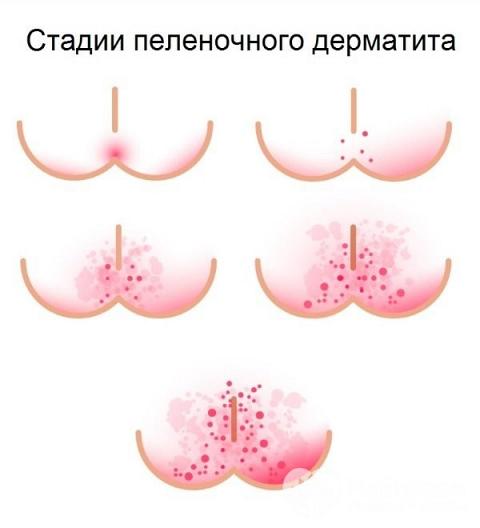
Stages of diaper dermatitis
Severe diaper dermatitis is characterized by an increase in the surface area of erosions and cracks. The surface of the affected skin begins to become very wet. Detachment of the affected epidermis often occurs, which leads to the formation of poorly healing ulcers.
Skin lesions with diaper dermatitis are accompanied by itching and burning, which causes tearfulness, poor sleep and decreased appetite in children. In adults, severe itching worsens the patient's mental state, causes insomnia, and causes depression.
Treatment of diaper dermatitis
During the examination, the doctor should talk with you and find out the features of the occurrence of diaper dermatitis. About the nature of feeding the child, the frequency of changing diapers. In case of infection or the presence of a rash in other places, the following tests may be prescribed:
- Bacteriological culture for streptococcus, staphylococcus and other pathogenic pathogens,
- General blood test (to detect allergies),
- Stool analysis for dysbiosis, as well as others.
Depending on the type of diaper dermatitis, along with preventive measures, the doctor may prescribe the following:
- Bathing in herbal decoctions: strings of chamomile, oak bark.
- Bathing in a light solution of manganese.
- Using any antibacterial or antiallergic cream, ointment, or mash.
- Breast-feeding
- Hypoallergenic diet
- In the case of the development of atopic dermatitis, antiallergic drugs, as well as enterosorbents, are taken orally: for example, activated carbon, atoxil, entorosgel, desloratotin, finistil, etc.
Causes
Babies are easy prey for this disease: their skin is very delicate, their immunity is not strong enough, and their thermoregulation functions are still imperfect.
In addition, many children have an allergy or a predisposition to it, which makes the skin even more vulnerable.
The immediate causes of diaper dermatitis are as follows:
- “greenhouse effect” - high temperature and humidity under the diaper;
- lack of air access to the skin under diapers and nappies;
- rubbing them, as well as clothes, on the body (this happens especially often if parents made a mistake with the size of the diaper or put it on incorrectly);
- the presence of various irritating components in urine and feces (for example, ammonia, salts);
- poorly selected creams and powders that cause inflammation on the baby’s skin;
- infection by pathogenic microorganisms, fungi.
According to experts, hygiene is the most important thing in caring for your baby..
Diaper dermatitis in adults
Diaper dermatitis develops not only in children, but also in adults, especially bedridden patients. Diaper dermatitis develops in cases where a person has lost the ability to control bowel movements and urination. Dermatitis manifests itself in the same way as in children: redness of the skin, the appearance of vesicles, small erosions, pustules, abrasions and diaper rash.
The appearance of this disease in adults is promoted by:
- The use of digestive enzymes (their excess is excreted in feces)
- Staying in diapers for a long time
- Decreased immunity
- Presence of chronic diseases
Treatment is carried out according to the same principles as in children. If this dermatitis in adults is not treated promptly, the likelihood of bedsores increases. To prevent the occurrence, it is necessary to regularly change diapers, clean the external genitalia, and also ensure that the skin is always dry. In case of excessive sweating, it is advisable to lightly dust the skin with talcum powder or use baby powder. It is advisable to take air baths regularly (at least two or three times a day).
The biggest mistakes of adults that cause children to suffer
Every parent wants to have a healthy child and doted on him. But often, some of them do not fully comply with the rules of child care (sometimes even experienced mothers). Of course, diseases can be cured, but it will be much easier if their occurrence is prevented. What parental mistakes cause diaper dermatitis in a child:
- purchasing chemicals harmful to the child’s body (creams, ointments);
- buying expensive or cheap diapers that are not suitable for their child’s skin;
- improper dressing of underwear, various items of clothing, diapers;
- bathing with frequently changing, untested soap products;
- excessive frequent use of various creams, oils, lotions and other products;
- using a bad towel, dry/wet wipes, rough fabrics;
- neglect to frequently check whether the child’s underwear is dry.
To save your child, and yourself, from suffering and pain, do not make these common mistakes. Because improperly worn underwear or an allergy to detergent can cause diaper dermatitis. Find out how to treat diaper dermatitis correctly.
In some children, diaper dermatitis becomes a chronic disease, but only the parents can be blamed for this. Because they delayed examination by a doctor until the last minute, trying to cure the disease on their own, or did not care for the child’s anal area, or turned to untested drugs, instead of following the advice of a specialist.
Folk recipes
Many recipes that include the use of various herbal plants that help fight the disease. They are passed down from the older generation and have been tested over the years.
But do not forget about precautions and contraindications. Some herbal plants can cause allergies and only harm the baby.
Decoctions for processing
To treat damaged areas, prepare decoctions of chamomile, calendula, string or oak bark. Infusions must be prepared correctly to have a positive effect.
Oak bark and string
To eliminate redness and irritation, an infusion of string and oak bark would be an excellent remedy. It dries out wounds and relieves unpleasant symptoms.
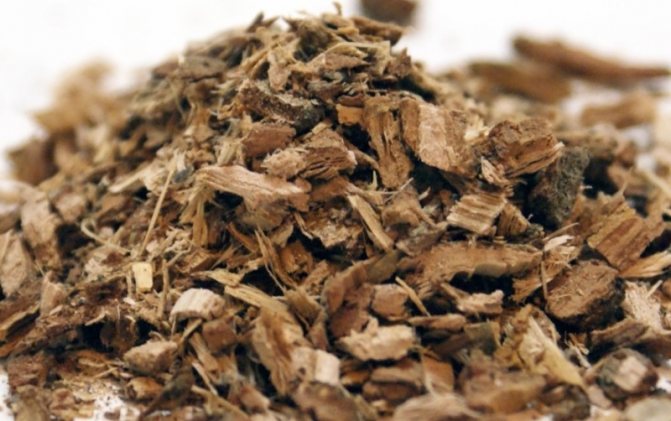
Cooking method:
- Grind 1 tablespoon of herb.
- Add 0.5 cups of boiled water.
- Leave in a dark place for 30 minutes. The broth should get a rich shade.
Moisten a bandage or gauze in the finished broth, apply and leave until completely dry 3-4 times a day.
Celandine
It is a very powerful remedy. It will help cope with diaper rash, but you need to apply it carefully.
The juice is diluted with water in a ratio of 1:2. After this, a bandage or gauze is soaked in it and applied to the injury.
Do not leave the infusion on the injury for a long time, do not apply bandages or compresses. In this case, the celandine will cause harm.
Lotions and compresses
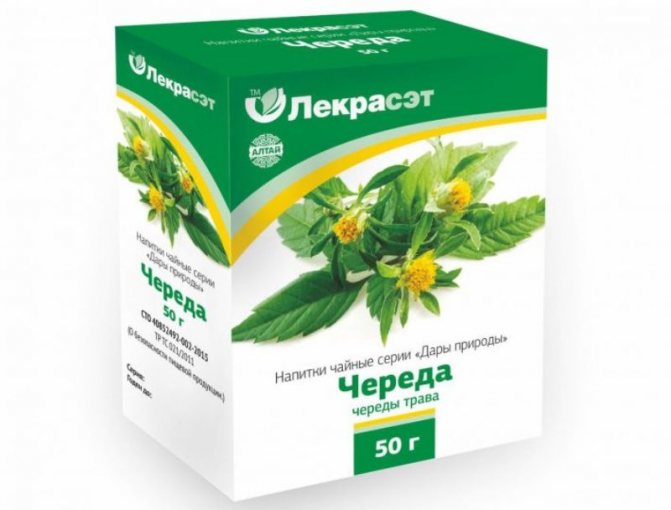
Herbs such as chamomile, calendula, mint and string are perfect for lotions and compresses. For preparation, use 25 grams of herbal collection, or a separate type.
The mixture is poured into a glass of boiled water. After this, boil for 15 minutes and leave to infuse for an hour.
An important rule in preparing compresses is that the finished broth must be filtered. Small particles can rub your baby's skin. They will remain in the folds and will only worsen the disease.
For lotions, infusions of birch buds are prepared. Then, 1 tablespoon should be diluted with a glass of water and brewed. It should infuse for 30 minutes.
Baths
Most decoctions are used as an addition to baths. The infusion is less concentrated and has less negative effects.
Chamomile
For a chamomile bath, take 2 tablespoons of the herb and pour boiling water over it. The decoction needs to sit before adding it to the bath. Be sure to strain the resulting infusion.
Add the required amount of water to the bath. This remedy will help eliminate inflammation.
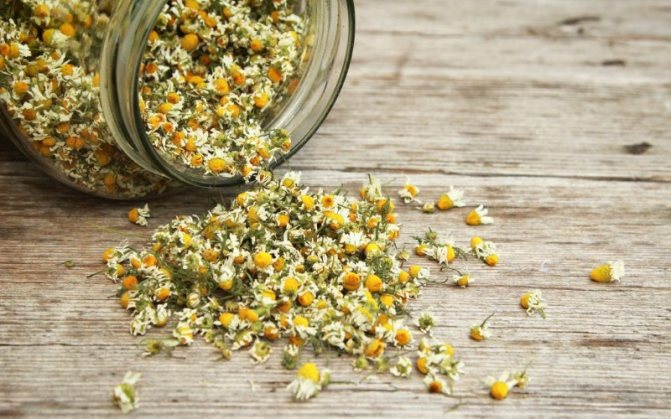
Oats
An excellent remedy would be oat straw. Cooking method:
- Take 500 grams of straw.
- Fill with 2 liters of water.
- Boil in a closed container over low heat.
- Strain and add to the bath.
This method will relieve pain and relieve inflammation.
Starch
Another remedy would be starch. Brew 4 tablespoons of starch in a small amount of water and add to the baby’s bath.
This therapy is carried out in a course of 10 procedures. You should bathe your child in a bath with additives every other day.
Natural oils

When treating dermatitis with folk remedies at home, natural oils are often used. There are a few basic rules here that should not be saved. In particular, they relate to the choice of oil.
Vegetable oil will not only not help the newborn, but will also cause harm. This is due to the fact that it forms a film that will not allow the skin to breathe. A greenhouse effect is formed and the symptoms will only intensify.
To combat the disease, you should give preference to almond and chamomile oils. You will need 20 ml of sweet almonds, to which one drop of chamomile is added.
Tea tree and peach seed oils are also used. The correct proportion of these oils is 1:20.
